Paris Neighborhood Guide
Paris is a city of Neighborhoods. This is true of most big cities, and especially true of cities which started out as tiny villages and have grown steadily over centuries; like Paris has. You’ll have read about the 20 arrondissements in Paris, the administrative districts which divide the main part of Paris. However, even within each arrondissement are smaller (and less easily-defined) neighborhoods which often overlap administrative borders.
The city’s 20 arrondissements are the easiest place to start when understanding the neighborhoods of Paris. However, so let’s start there.
Paris Arrondissements
As mentioned, there are 20 arrondissements in Paris. The word “arrondissement” is also used by the country of France to describe larger administrative divisions, and the cities of Lyon and Marseilles are also broken up much the same way Paris is.
The 1st arrondissement, which incorporates part of the first settlement of Paris on the Ile de la Cite, is viewed as the very heart of the city center. From that spot, the arrondissements work their way out in numerical order in a spiral manner, progressing clockwise. So the 2nd arrondissement is above and to the right of the 1st, the 3rd is to the right and slightly lower than the 2nd, the 4th is below the 3rd, etc. You can see it clearly if you look up at the map at the top of this page.
Go ahead, I’ll wait.
See it? Cool, huh?
Here’s something else that’s really cool. When you’re looking at addresses in Paris, you don’t need to pinpoint a location on a map to find out what arrondissement it’s in. All you need is the zip code. All Parisian zip codes begin with 750, and the last two digits are the arrondissement the address is in. 75018 is the 18th arrondissement. 75007 is the 7th. It’s that simple.
There are more arrondissements on the Right Bank of the Seine than the Left Bank. However, there are equally good arguments for spending time on both sides of the river. That way you can explore as much of the city as you possibly can. Because, as we’ve already established, Paris is a city of neighborhoods.
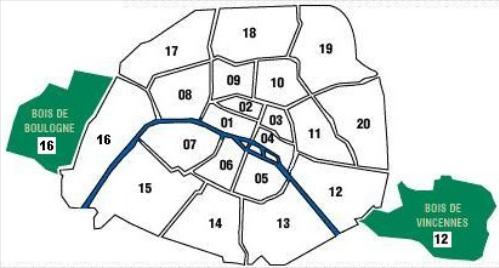
Popular Neighborhoods of Paris
Long-time Paris residents get so used to their own particular neighborhood that many of them feel like they need a really good reason to venture too far off their well-worn path. This is especially true if you’ve got a good relationship going with your local butcher, fruit seller, hairstylist, etc. Who wants to go back to the bottom of the totem pole and not get the best cuts?

But as a visitor in Paris, you’re free to wander from neighborhood to neighborhood without worrying about firming up a good working relationship with the fishmonger.
Most travelers in Paris will want to stay in a neighborhood that represents everything that the city has meant to them over the years; the Paris of dreams, the one that called to you from afar; the one that made you get the plane ticket in the first place. You’ll also probably want to focus on an area that gives you easy access to public transportation so you can get around and see what you want to see. You might even want to be within walking distance of a couple of the big attractions just for ease. There will be safety considerations and budget considerations, as well.
But these are minutiae. To get a better sense of Paris neighborhoods, here’s an overview of some parts of the city where you’ll likely be spending most of your time. They’ll all have some accommodation options, some attractions, some restaurants, and some shops; however, the feel of each neighborhood may be slightly different. So read these descriptions and see which one sounds best for your trip.
Paris Islands: Ile de la Cite and Ile St. Louis (1st & 4th arrondissements)
The two big islands at the heart of Paris are where it all began. Paris’ earliest settlers chose these islands as the ideal location for trade and for defense. The Ile de la Cite is truly where the city was born more than 2,000 years ago. It’s also where you’ll find one of the city’s most famous landmarks; the Notre Dame Cathedral. The Ile St. Louis is decidedly more peaceful, as it lacks any “sights,” but it does have the best ice cream in Paris.
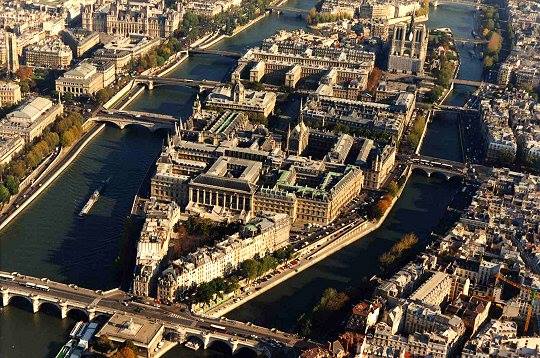
If you want to spend your days walking along the Seine or searching for the best camera angles of Notre Dame’s gothic facade, you’ll want to start your days on the islands. Ile St. Louis is particularly romantic at night. The traffic slows down to a trickle; some hidden bars and clubs can be found here, which I’ll let you discover on your own… Call it my sixth sense – but I think the Ile St. Louis is bewitched – or bewitching. One thing is certain if you spend enough time on the islands, the most unusual things will happen.
The Marais (3rd & 4th arrondissements)
Known today as a trendy area crammed with chic boutiques and the center of the gay community in Paris. Also, The Marais has historical ties to the Parisian Jewish community and even the French aristocracy. The elegant townhouses which line the beautiful public squares in Le Marais used to house royals. Until they all fled to Versailles once the King moved his court there.
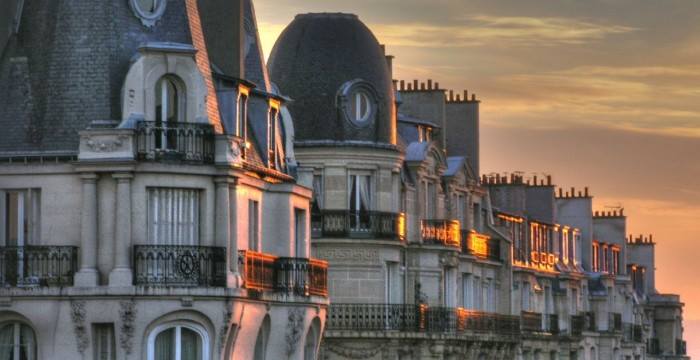
Luckily, many of the gorgeous Marais buildings have been turned into boutique hotels and rental apartments. At the same time, others contain some of the area’s charming shops and bistros. Marais district has become a popular area for tourists who are looking for some of the beauty of Paris past. There’s no better square than the Place des Vosges to while away a Sunday afternoon in Paris and imagine the jousting tournaments that robbed a Medici queen of her ill-fated husband. This has always been my favorite square in Paris since the days back in the 1970s when the decrepit townhouses looked still haunted by their long-dead former residents.
Montmartre (18th arrondissement)
The hilltop church of Sacre-Coeur is the crown jewel of the Montmartre district, soaring above the city of Paris and serving as a stark contrast to the bohemian neighborhood surrounding it. The area has long been a magnet for artists and anyone seeking budget accommodation or cheap eats, and it’s still a great place for budget travelers to focus on today (though it’s decidedly more expensive than it used to be).

Montmartre enjoyed a surge in popularity following the success of the film “Amelie”. The movie was set in this famous district, but visitors will still find a steady stream of locals and tourists alike in the neighborhood (despite the long hike up the stairs!). There are quite a few hostels in Montmartre, as well as budget hotels and B&Bs.
The Latin Quarter (5th & 6th arrondissements)
Another popular area for budget travelers is The Latin Quarter, so named for the language spoken by students at the Sorbonne University, which has been in this neighborhood since the 12th century. Students still make up a big reason why The Latin Quarter is well-known to budget travelers, although rents have soared in recent years, forcing actual students to look elsewhere for lodging. While the students now largely live outside The Latin Quarter, there are still lots of great options for eating cheap in Paris in this area; and the excellent nightlife remains one of the things that continues to draw people after dark.
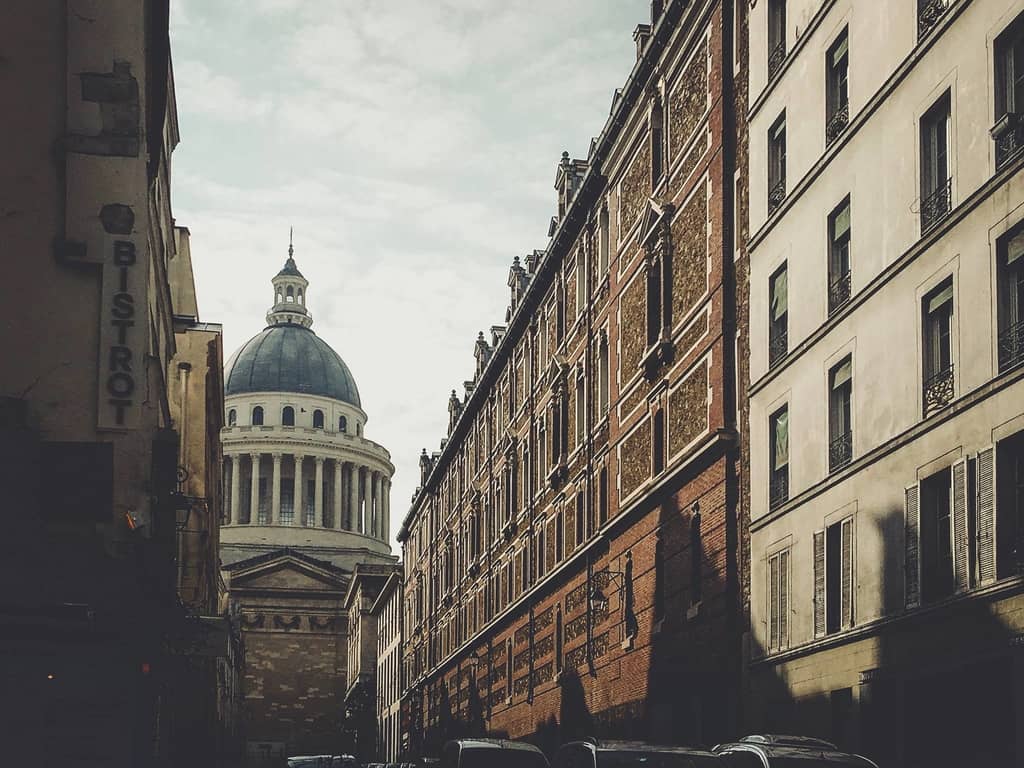
In The Latin Quarter, you can still find reasonably priced meals in the vicinity of Boulevard St. Michel amid the honeycomb of restaurants between St. Andre-des-Arts and Odeon. Movie theaters run all the films that you thought you’d never be able to see again on a big screen. The domes of La Sorbonne and Pantheon hover above the constant ebb and flow of pedestrians lugging notebooks, portfolios, and now laptops and cellphones. Students huddle in cafes, probably complaining about the same world problems that have yet to be resolved by the last generation that sat complaining before them.
There are vestiges of Paris’ medieval past most often hidden by restaurant signs selling Greek souvlaki or North-African couscous. However, no great efforts have been made to exalt what is ‘old’ about The Latin Quarter. In one corner, tucked away from the larger thoroughfares, the Roman Arena has been preserved, but without much to-do. Kids play games in the arena center. This is the kind of place you can go and lose yourself in Paris’ past. Go there to think about what Paris must have been as a Roman outpost, so long ago.
Also Read: Where To Eat At The Latin Quarter, Where To Stay At The Latin Quarter
St. Germain-des-Pres (6th arrondissement)
While shoppers will find a wide variety of shops to keep them happy in just about any part of Paris, in St. Germain-des-Pres, the offerings are particularly striking; especially if you’re into antiques or fashion, and it’s an enjoyable area even if you’re only interested in window-shopping. And if you’re not, this is also the district where you’ll find the famous (and, some say, overrated and overpriced) cafe, Les Deux Magots.
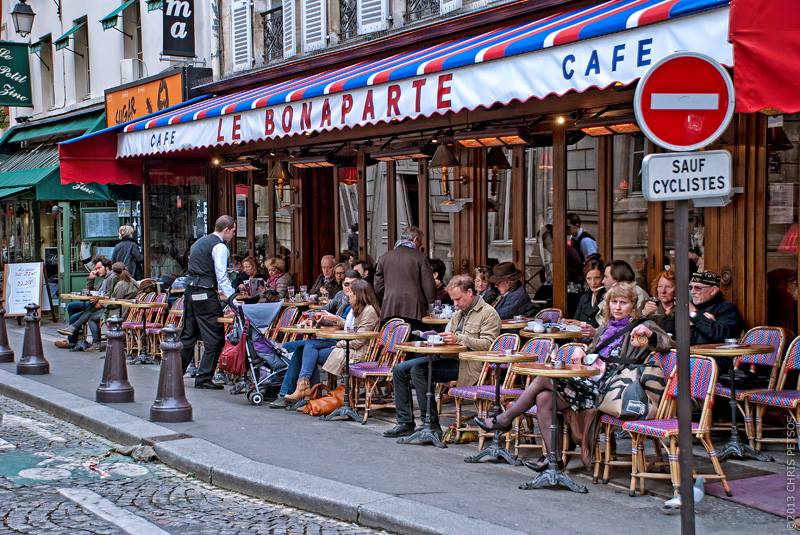
St. Germain-des-Pres is an excellent place to do some serious people-watching. Hang out at the Armani Cafe. Visit the Village Voice English language bookstore on Rue Princesse. Start at Rue Canette and just wander until you find a friendly bar or cafe to catch an apero at dusk. Lose yourself in the maze of streets between Boulevard St. Germain and the Seine River. Browse retro clothing stores and antique shops. Enjoy some music at one of the jazz clubs. Just don’t come to the St. Germain-des-Pres neighborhood with a set agenda. It’s the ideal neighborhood for flanerie – flitting about.
Montparnasse (14th arrondissement)
Like the other famous Paris “mont,” Montmartre, the Montparnasse neighborhood has also historically been linked to great artists and thinkers (also known to some as “rabble-rousers”); including Hemingway, Simone de Beauvoir, Jean-Paul Sartre, and Modigliani; particularly during the period in between World War I and World War II. The area has quieted down since those days, but students still frequent its cafes, and tourists in the know are drawn to the cheap hotels and overall lack of pretension. This is also the part of Paris where you’ll find the Cemetery Montparnasse, a popular attraction because of its many famous graves.
The Montparnasse neighborhood has gone through some major ‘upgrading’ in the past few years, particularly around Rue de la Gaite. Yes, there are still some sex paraphernalia and video shops mixed in amongst the legitimate theaters, and some might compare the Rue de la Gaite to a mini-Times Square. The ambiance. However, remains completely neutral and quite safe, even if single men may be discreetly directed toward one of the few risque establishments!
Montparnasse is where I live in Paris, so I’m biased; but this is one area that just is, was, and will continue to be nothing more than what it is. Which, in my opinion, is a really cool place to hang out.
Eiffel Tower & Invalides (7th & 15th arrondissements)
The Eiffel/Invalides section is highly evident and heavily-visited, largely thanks to their landmarks. Les Invalides, where Napoleon is buried, and the Eiffel Tower itself. There is no shortage of places to stay in this part of Paris. However, as you might imagine, many of them are not what many people would call “budget” options. There are some budget hotels near the Eiffel Tower, however.
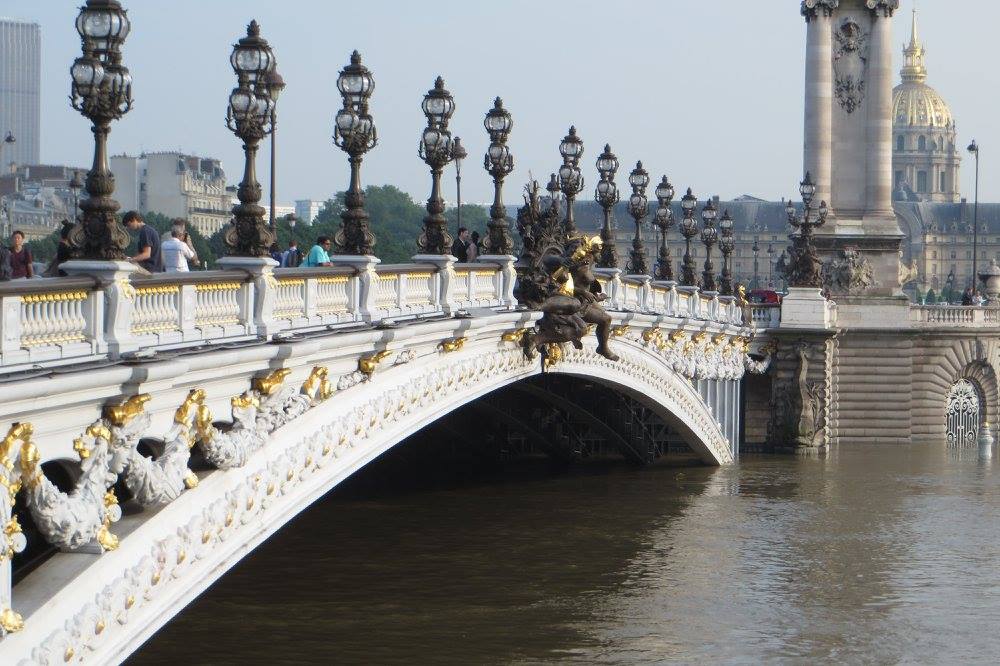
Still, the 15th arrondissement is a bit less touristy than some other popular Paris neighborhoods (the Eiffel Tower is in the 7th), so you may find some hotel deals. Rick Steves likes to recommend the Rue Cler for budget lodging; if you’d like to avoid bumping into his fans, then it’s probably best to look elsewhere. The Rue Vaugirard, Paris’ longest street, is more focused on local than tourist trade and can give you a better look at what real life in Paris is like. This is also a good place to be if you’re planning on sharpening your cooking skills at Le Cordon Bleu cooking school.
“The Splurge Neighborhood” (1st, 2nd, & 8th arrondissements)
Is “The Splurge Neighborhood” an official name for a Paris neighborhood? No, it’s not – but it’s an apt moniker for this Right Bank area that includes the Louvre Museum, the Champs-Elysees, and some of the city’s best high-end shopping options. The good news is that walking through this pretty part of the city (and even window shopping) is completely free; as is enjoying a sunny day in the Tuileries Gardens!
I would recommend this neighborhood for anyone who doesn’t worry about expenses. (And with Baron Haussman’s straight avenues and boulevards in this area, it’s also a good neighborhood for people who get easily lost!) While you may have to adjust the meaning of the word “budget” in your mind, there are some budget hotels near the Louvre. They are worth checking out if you’ve got your heart set on staying in this area and don’t have a trust fund.
Other Paris Neighborhoods
While you may spend less time in these parts of Paris (especially during your first couple of visits to the city when you’re madly trying to check off things in your to-do list); here’s a bit of information about places you might want to explore as well.
Grands Boulevards (2nd, 8th, and 9th arrondissements)
We almost moved to the 9th. However, I decided having so many huge department stores within walking distance would be a mistake! This is, after all, where you’ll find the flagship store for Galeries Lafayette as well as the big Au Printemps. Both located on Boulevard Haussmann. Visitors who are only in town for a short time shouldn’t be able to do too much damage to the bank account. If they book a hotel within walking distance of either store; a nearby hotel is recommended if you actually plan to do lots of shopping.
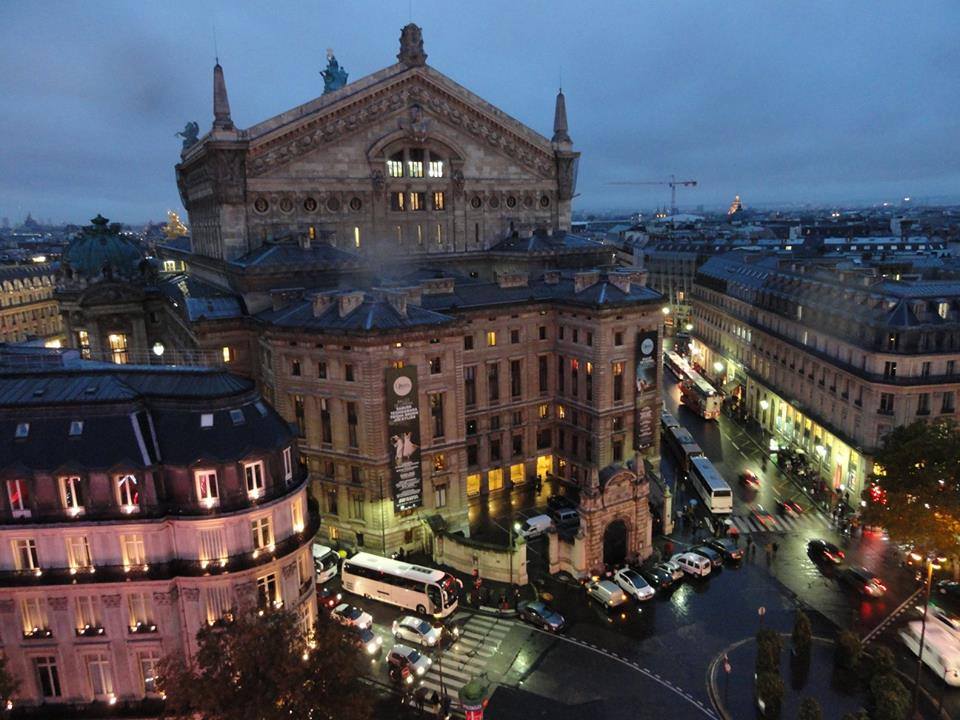
The Grands Boulevards area has more to offer than just shopping, however. Denizens of the night will gravitate toward Rue Faubourg Montmartre; the nightclubs are in constant flux, but turn-of-century Restaurant Chartier remains a familiar neighborhood fixture.
Beaubourg & Les Halles (1st & 4th arrondissements)
Beaubourg is the name of a Paris neighborhood, but it’s also become the local name for the area’s most famous museum; the Centre Pompidou. With the industrial pipe facade of Pompidou juxtaposed against the surrounding medieval passages and pedestrian walkways, you can’t help but feel caught in a time warp.
One thing I like about this neighborhood is that you’re bound to stumble into a pub sooner or later where you can drink a Guinness, or find a cafe with the traditional zinc bar. Centre Pompidou attracts plenty of students; and as I’ve mentioned in past posts, the Pompidou library is considered an ideal place for trawling. The area really comes to life at dusk.
The Les Halles area takes its name from the huge public marketplace, which used to be there. The neighborhood had been a traditional market area for years when a shelter was finally built in the late 12th century. The Les Halles market structure that was famous was built in the 1850s, but it was, unfortunately, torn down in 1971. There’s still a market in the neighborhood, but it’s new, and now it’s underground; and it’s decidedly more mall-like these days.

Bastille & Bercy Village (11th & 12th arrondissements)
You want to see the other Paris? You may want to consider setting up headquarters in the east or northeastern section of Paris. The focal point for the Bastille neighborhood is Francois Mitterand’s Bastille Opera House, which is diametrically opposed to the 19th century Garnier opera house. The new opera house generated a beehive of activity in the neighboring streets, from art galleries to music shops, which continues to this day.
The #14 Metro line connects Bercy Village to the Bibliotheque Nationale in the 13th arrondissement. Bercy Village is the place where Parisians go for a stroll on a sunny weekend. The old wine storage area has been brilliantly converted to shops and restaurants. It has succeeded in the way that the Forum at Les Halles never will, probably partly because it started with the title “Village,” a word near and dear to Parisians. This is also the new home for La Cinematheque Francaise. So, if you’re a film buff, you may want to consider positioning yourself within walking distance of 51 Rue de Bercy for night and day access to film screenings in the Frank Gehry-designed Cinematheque.
You can while away your summer afternoons in the Bercy park, then head over to Cour St. Emilion at Bercy Village for a little wine tasting. I could get used to this neighborhood if I weren’t already faithful…
Oberkampf (11th arrondissement)
Located in Paris’s eastern sector, Rue du Oberkampf has always been considered a blue-color neighborhood. In recent years, the stirrings of artistic souls migrating from Bastille and the 20th arrondissement have placed Oberkampf in the “circuit”. Especially if you are interested in finding less predictable Paris nightlife.
For fans of world music, I recommend the Satellit Cafe in the Oberkampf neighborhood.
Trocadero & Arc de Triomphe (16th arrondissement)
If you live in the 16th, I’m going to guess that you’re a diplomat or ambassador – or the ambassador’s spouse. This is the neighborhood of the “ladies who lunch.” Because I don’t run in these circles (even though I do lunch in the 16th), I can only tell you this about the 16th arrondissement. If you say you’re staying in the 16th, you are making a statement. The 16th has cache. It always will.
The 16th has some lovely parks (like Ranelagh). From there, you can skip over to the Bois de Boulogne and jog forever through forested paths (but come home before dusk, unless you should be mistaken for one of the dames de nuit). The 16th wouldn’t be my first choice for a place to stay in Paris simply because it’s too far removed from many of the major attractions; not to mention the high prices you’re likely to find for hotel rooms there. Although it’s definitely worth exploring if you’d like some of that aforementioned cache to rub off on you.

Northeast Paris (10th, 19th & 20th arrondissements)
The northeast parts of Paris are, in my opinion, ideal for trendsetters and the insatiably curious. If you come to Paris via Eurostar, you’ll be coming into Gare du Nord in Paris’ 10th arrondissement. However, this is not the neighborhood I’d recommend finding a hotel. The Gare du Nord & Gare de l’Est surroundings have been described by hotel reviewers as “dicey.” However, if you’re working with a small budget, you may find a place to meet your needs.
The famous St. Martin canal passes through the 10th (canal tours are possible). The 20th is home to indie rock club La Fleche d’Or. If you’re a cemetery buff, you can spend an afternoon at the Pere Lachaise Cemetery. The Belleville area abounds with inexpensive Asian restaurants. Paris’s 10th arrondissement, nicknamed La Goutte d’Or (a drop of gold), is primarily an immigrant neighborhood.
The “Insolite” Neighborhood (13th arrondissement)
There’s more than meets the eye when it comes to the 13th, the insolite (unusual) arrondissement. The first thing that hits you smack in the forehead is the wall of highrises at Porte de Choisey, on Boulevard Massena, and Porte d’Ivry (Paris’s Chinatown).
It all began in the mid-1970s when waves of Vietnamese, Cambodian, and Chinese refugees arrived in France. Go to the 13th for a good Peking duck meal, or traditional Cambodian soups at the Tricotin restaurant. There are the harder-to-find neighborhoods of the 13th, like the Cite Fleurie artists’ ateliers (a private residence), or the complex of streets named for flowers where France’s movie crowd likes to live in peaceful separation from the city’s usually frenetic pace.
I would recommend the 13th arrondissement only for return visitors looking for a totally different Paris experience (which is best appreciated on a bike or walking tour). Otherwise, the 13th is just too far from the city’s major sites to be a good base for most tourists.
Which Paris Neighborhood is Best?
This is, as you might guess, an impossible question to answer because each visitor to Paris will need to choose the best part of the city to stay in or spend time in based on his or her personal needs and goals. But here are some things to consider when you’re trying to narrow down your options.
Most of the major Paris attractions can be easily accessed from the first eight arrondissements. As a first-time visitor, I’d suggest looking for a hotel in one of the first six arrondissements; with an emphasis on Ile Saint Louis (the island right next to Notre Dame), the Marais (Place des Vosges), St. Germain des Pres, or Rue de Rivoli (near the Louvre). These are, unfortunately, traditionally not very cheap areas when it comes to hotels. However, so if you’re on a budget, then look just outside these popular neighborhoods for easy access to the same sights for a fraction of the cost.
The only two major monuments not within walking distance from these first six arrondissements would be the Eiffel Tower and Sacre Coeur. The St. Ouen/Porte de Clignancourt flea market can be reached quickly from the Montmartre neighborhood, which borders St. Ouen (but you can just as easily hop on the #4 Metro line from as far as the Left Bank). Pere Lachaise Cemetery is located in the last arrondissement, the 20th, completely to the east of the city center.
No matter where you choose to stay, the Metro in Paris does an excellent job of getting you to any parts of the city. If you don’t feel like taking the Metro and you enjoy walking, you’ll be able to walk to many of the major sites (except Montmartre, which is too much of an uphill hike for most people, and Pere Lachaise, which is just too far from the city center). The bus system is almost as good as the Metro (during the day). And now there’s Velib bike rentals that adds a new dimension to city transport.
17th Arrondissement
Eagle-eyed readers may have noticed one arrondissement is missing from this summary – the 17th arrondissement in Paris’s northwest. This is a residential neighborhood which is very Parisian. I am sure of this because our friend named France grew up here. She thinks this is the most Parisian part of Paris. It must be because you will rarely find it a guide book. So we will respect the 17th’s privacy – at least until I find something there that I can’t resist sharing.
